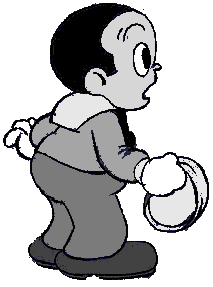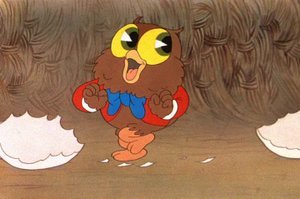Animation Nation
Tex Avery Loves to Singa
Tex Avery Loves to Singa
By Ed Garea and Steve Herte
I Love to Singa (WB, 1936) – Director: Tex Avery. Animators: Chuck Jones,
Virgil Ross, & Bob Clampett. Voices: Billy Bletcher, Tommy Bond, Joe
Dougherty, & Martha Wentworth. Color, 8 minutes.
Slowly, but surely, Leon Schlesinger began to recover from his
personal debacle of 1933, when Rudolf Ising and Hugh Harman’s dispute over
budgets led to the animators leaving Schlesinger for the cozier climes of MGM.
What particularly stung was the fact that Harman and Ising took their animated
creation, Bosko, with them, as they owned the rights, leaving Schlesinger
without a main attraction.
Schlesinger attempted to fill the void with the creation of
another cartoon star, Buddy, created by animator Tom Palmer. But Schlesinger
hated Buddy from the start; so unhappy was he with the first cartoons he
screened, that he sacked Palmer and brought back Friz Freling (who had left
with Harman and Ising) to fix the cartoons into something that could be
released to Warners.
Buddy was perhaps the most unappreciated cartoon star of all time,
starring in only 23 shorts before Schlesinger and his crew dumped him in search
of new characters. As with his predecessor Bosko, music dominated the cartoons
and plots were treated almost as an afterthought. But over the life of the
series the plots began to become more complex and Buddy gained a girlfriend
(Cookie) and a dog to tag along on his adventures. In 1935 the character was
retired in favor of Beans the Cat, who didn’t last long with the animators,
either. (See Trivia) It wasn’t until Porky Pig came along that Schlesinger
finally had a main attraction for his cartoons.
Meanwhile, in the wake of the void left by the departure of Harman
and Ising (who took their animators with them), Schlesinger began hiring new
talent. Fred “Tex” Avery came over from the Walter Lantz studio and fast-talked
Schlesinger into letting him head his own production unit. Schlesinger agreed
and assigned animators Chuck Jones, Robert Clampett, and Virgil Ross to the new
unit. (They dubbed the building in which they worked as “Termite Terrace” due
to the large population of the insects there.) It turned out to be the best
hire Schlesinger made, as Avery and his co-horts began to create a new style of
cartoon.
The new unit’s first cartoon, Gold Diggers of ’49 (alluding
both to the famous California Gold Rush and to the popular series of Warner
musicals from Busby Berkeley), set the mark for the direction Avery and his
unit would take. Though its star was Beans the Cat, it was Porky Pig who stole
the cartoon and became a star in his own right.
Avery and his unit were initially assigned to make Looney
Tunes, which were strictly black and white. To make an entry in the Merrie
Melodies series, which were in color, meant that the cartoon had to be
shaped around a song, taken from the vast Warner Brothers library. This Avery
did, and in doing so, he created what later critics see as an early
masterpiece, and one that has gained a cult following over the years.
I Love to Singa is a fond parody of The Jazz Singer. It opens
with an iris shot featuring a house in a tree. A sign hanging near the door,
reads “Prof. Fritz Owl, Teacher of Voice, Piano, and Violin, BUT – No Jazz!”
Inside Papa Fritz is pacing back and forth as Mama Owl is sitting on four eggs.
Finally she nods with a smile – the eggs are about to hatch. The Professor
(voiced by Bletcher) taps each with his conductor’s wand and gets a harmonious
sound from each until he taps the last egg; it rings with a metallic clang. The
first hatchling comes forth singing the opening of "Chi mi frena in
tal momento" from the opera Lucia di Lammermoor. “Ah, what a
fine voice,” Papa Fritz exclaims, “A Caruso.” The next hatchling enters the
world playing the beginning of “Traumerei” by Robert Schumann on the violin.
“What sweet music, a Fritz Kreisler,” says Papa Fritz. The third comes out
playing Felix Mendelssohn’s “Spring Song” on the flute, and Papa Fritz calls
him “another Mendelssohn.” The last youngster (voiced by Bond) upon hatching
(and dressed in a red coat with a blue bow tie) looks at his father and says
“Hello Strenza!” (See Trivia) He then launches into the title song. “Ach! A
Jazz Singer! A Crooner! Stop! Stop! Stop!” exclaims Papa Fritz as Mother
faints. Papa fans her and tells her not to worry, “Listen Mama, if we must
sing, we will teach him to sing like we want him to.”
However, all is not going to plan. Forced to sing “Drink to Me
Only With Thine Eyes,” while his mother accompanies him on the pump organ, the
youngster does a little rendition of “I Love to Singa” between verses. He’s
caught doing this by Papa Fritz, who picks him up and boots him out of house,
yelling, “Enough is too much! Out of my house, you hotcha, you crooner, you
falsetto, you jazz singer! You, you, you!” The youngster takes it all in
stride, pointing back and telling us “That’s mein pop.” He then goes on his
way, whistling the title tune. Meanwhile, Mama Owl (voiced by Wentworth) is
telling Papa Fritz that he was too hard on the boy. She calls the police,
describing him as “a little fellow with big eyes and a red coat.”
As the youngster is walking he notices music coming from a tree.
It’s radio station GONG, which is broadcasting “Jack Bunny’s Amateur Hour.”
Numerous contestants are gonged and dropped down a trap door. One stutters his
way through the rhyme “Simple Simon” before saying “Oh well, shucks,” and gongs
himself down the trap door. (He was voiced Joe Dougherty, the original voice of
Porky Pig.) Cut to Mama Owl as she listens to the police report on the radio.
She wonders if the police have found her son, to which the radio answers back
“No we didn’t lady,” as both Mama and Papa Owl look at each other in
astonishment. This was the first use of a trick Avery was to repeat and be
noted for in later cartoons: breaking the bounds of reality to enhance the
laughter.
Finally out young hero gets to show what he can do. When Jack
Bunny asks who he is, he’s handed a card that simply reads “Owl Jolson.” He
then breaks into his song, which is winning Jack Bunny over to the extent that
he’s getting out the “First Place” trophy. Mama hears him singing on the radio
and bring Papa and the children to see him. They are looking through the window
of the studio when young Owl notices them and freezes. He then lapses back into
his rendition of “Drink to Me Only,” and Jack Bunny is about to gong him. Papa
and the family enter and Papa shouts, “Stop! Stop! Stop! Enough is too much!”
He turns to his son, “Go on and singa about your moon-a and your June-a and the
spring-a.” Young Owl returns to his music and the cartoon ends with Jack Bunny
handing him the First Place trophy. The film irises out to black, but the
trophy remains outside. Young Owl opens the iris and grabs his prize before the
cartoon officially ends.
This combination of a strong plot with tricks such as the radio
gag, was to launch a new style in cartoons, as Schlesinger’s unit slowly moved
away from a simple animated backing for a song to entities in their own right,
establishing strong, and eventually lasting, characters, and shifting the music
to the background. We see the beginnings of this new philosophy of cartoons
here, for although the cartoon is supposedly built around the song, in
actuality, the song itself becomes secondary to the story of young Owl Jolson
and is used to explain his persona. Leon Schlesinger and Warner Brothers came a
long way since the debut of Bosko in 1931’s Sinking in the Bathtub.
Trivia: The
short is one of the earliest Merrie Melodies produced in
Technicolor’s three-strip process.
The song, “I Love to Singa,” was written by Harold Arlen and E. Y.
Harburg and featured in the 1935 Warner Brothers musical The Singing
Kid, where it was performed three times: first by Al Jolson and Cab
Calloway, then by the Yacht Club Boys and Jolson, and finally by Calloway and
Jolson.
Bert Lahr supplied the original voice of Papa Fritz, but Billy
Bletcher replaced him in the final version. There are rumors that while Tommy
Bond did the voice of Owl Jolson, Johnnie “Scat” Davis did the singing. That isn’t
true.
“Hello Strenza!” is a Yiddishism for “Hello, Stranger,” and was
the catchphrase of a character from Jack Benny’s radio program named
“Schlepperman.” (To “schlep” in Yiddish means “to drag along.”) It was a
popularly quoted catchphrase of the day.
Buddy made a weird comeback of sorts in a 1994 episode of Animaniacs titled
“The Warners’ 65th Anniversary Special.” In this episode it was
revealed (according to the series’ fictional history) that Yakko, Wakko and Dot
were created to add life to Buddy’s very dull cartoons. During the cartoons
they would smash Buddy over the head with a mallet. After Buddy was dropped by
the studio and replaced by the Warners, he retired to Ojai, where he earned a
living as a nut farmer, all the while plotting revenge against the Warners.
This came to a head on the Anniversary Special where he tried to exact his
revenge but was foiled in the attempt.
The cartoon is also referenced in the very first episode of South
Park (August 13, 1997) titled “Cartman Gets an Anal Probe.” During the
course of the episode, whenever an alien beam hits Cartman or Officer Barbrady,
they break into “I Love to Singa,” as warbled by Tommy Bond.
For those interested, the cartoon is available in a beautiful
digital Technicolor transfer as an extra in the three-disc Deluxe Edition of The
Jazz Singer. It is also included in the Looney Tunes: Volume 2 DVD,
and Looney Tunes: The Platinum Collection, Vol. 1 (also
available in Blu-ray).




No comments:
Post a Comment